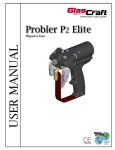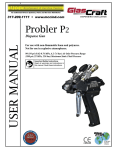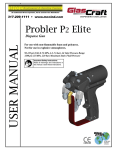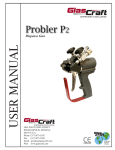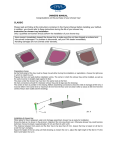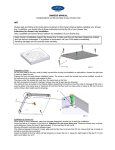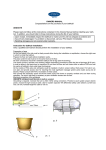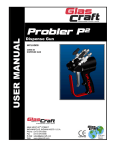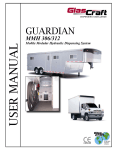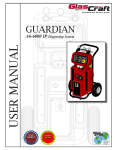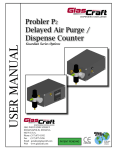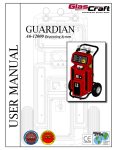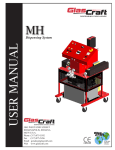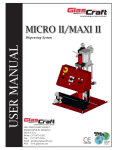Download USER MANUAL - Source of Supply in Polyurethanes
Transcript
Probler P2 EN T IS P R T U.S.A. PATENT 6,796,461 CT ED B Y HI M TE O S E Q UI P USER MANUAL Dispense Gun Table Of Contents Section 1 Installation 1:1 Introduction ........................................................................................................................................................ 1:2 Standard Equipment .......................................................................................................................................... 1:3 Specifications ..................................................................................................................................................... 1:4 Equipment Assembly .......................................................................................................................................... 1 2 N/A 3 Section 2 Operation 2:1 Start-up Instructions ........................................................................................................................................... 5 2:2 Shut–down Instructions ...................................................................................................................................... N/A 2:3 Daily Start-Up Instructions ................................................................................................................................. N/A Section 3 General Information 3:1 Assembly Drawings ............................................................................................................................................. 7 3:2 Sub Assembly Drawings ......................................................................................................................................N/A 3:3 Maintenance ........................................................................................................................................................ 9 3:4 Troubleshooting ................................................................................................................................................... N/A 3:5 Options ................................................................................................................................................................ 14 Section 4 Safety Information 4:1 General Safety .......................................................................................................................................... 21 4:2 Notes ...................................................................................................................................... 25 4:3 Limited Warranty Policy ............................................................................................................ 27 4:4 Technical Assistance ................................................................................................................ 28 For Your Reference ............................................................................................. INSIDE BACK COVER N/A = Non Applicable Introduction The information in this document is intended only to indicate the components and their normal working relationship typical use. Each assembly should be directed by a GlasCraft distributor or made from the GlasCraft Assembly instructions provided. Before operating, maintaining or servicing any GlasCraft system, read and understand all of the technical and safety literature provided with GlasCraft products. If you do not have the proper or related manuals and safety literature for your GlasCraft system, contact your GlasCraft distributor or GlasCraft,Inc. This manual provides information for the assembly, operation, maintenance and service of this GlasCraft product as used in a typical configuration. While it lists standard specifications and procedures, some deviations may be found. In this GlasCraft technical and safety publication, the following advisories will be provided where appropriate: Is information about the procedure in progress. In order to provide our users with the most up-to-date technology possible, we are constantly seeking to improve products. If technological change occurs after a product is on the market, we will implement that technology in future production and, if practical, make it available to current users as a retrofit, up-date or supplement. If you find some discrepancy between your unit and the available documentation, contact your GlasCraft distributor to resolve the difference. GlasCraft, Inc. reserves the right to change or modify this product as it deems necessary. Is imperative information about equipment protection. CAUTION Indicates a hazardous situation which, if not avoided, could result in minor or moderate injury. WARNING Careful study and continued use of this manual will provide a better understanding of the equipment and process, resulting in more efficient operation, longer trouble-free service and faster, easier troubleshooting. Indicates a hazardous situation which, if not avoided, could result in death or serious injury. ELECTRICAL SHOCK HAZARD Indicates a hazardous situation which, if not avoided, could result in electrical shock or serious injury. Sec. 1:1 Section 1 - Installation: Introduction Sec. 1:2 Section 1 - Installation: Standard Equipment Standard Equipment Part Description Number 23950-XX Probler P2 Dispense Gun GC-1386 User Manual How The Gun Works GlasCraft Equipment The trigger actuates a small valve in the gun handle that controls the flow of air into the piston assembly. When the trigger is pulled, air flows through the valve to the front of the piston. Air pressures force the piston towards the rear of the gun, simultaneously closing off the purge air and moving the mixing chamber to a position where the mixing chamber orifices are aligned with the orifices in both, the side block seal and check valve assemblies. All GCI OEM fittings are as follows: A SIDE - # 6 JIC Hoses – Female Swivel Fitting System and Gun – Male Fitting B SIDE - # 6 SAE Hoses – Female Swivel Fitting System and Gun – Male Fitting Air Hose is ¼” NPS JIC and SAE Fittings DO NOT require the use of teflon tape. The proper alignment of the orifices is determined by the setting of the Set Screw, p/n 17259-16F, located at the rear of the piston assembly. This set screw determines the length of travel of the air piston and has been preset at the factory and should not require adjustment. (SEE MAINTENANCE SECTION) Once the fittings are attached and tight, refer to system manuals for start-up instructions. The two fluids (isocyanate and polyol) then flow thru the material shut-off valves, seal, and check valve assemblies and into the mixing chamber. The two fluids impinge against one another and exit the mixing chamber in a swirling, conical spray pattern. When the trigger is released, the mixing chamber returns to its original position and purge air flows into the Mixing chamber housing, p/n 23963-00. The front tip o-ring, p/n 23974-00 keeps air purge inside the gun head, p/n 23963-00, forcing all of the air through the orifices in the mixing chamber, for a complete, total and constant purge. This purge air continues to flow thru the mixing chamber until the air switch, p/n 16832-00 is pulled up to shut-off all air to the gun; or until the trigger is pulled again. Sec. 1:4 Section 1 - Installation: Equipment Assembly Sec. 1:4 Section 1 - Installation: Equipment Assembly Installing P2 on Equipment other than GlasCraft 3. Install the original fittings into PG-15-01 valves. It is recommended to use a non-permanent thread lock on the 1/8 in. NPT threads to assist as a sealant and keep the fittings from twisting with gun movement. Do not place any part of the body in the path of the material spray. Do not point the gun at or near other personnel. Do not look into the mixing chamber orifice at any time. Because of the hazardous materials used in this equipment, it is recommended that the operator use an air mask, goggles, protective clothing, and other safety equipment as prescribed by current regulations, recommendations of the chemical suppliers, and the laws in the area where the equipment is being used. 4. Install the gun on the original Hoses. The air slide valve, p/n 16832-00 is a ¼ in. NPSM. Relieve ALL system fluid and air pressures according to manufacturer’s instructions. If original equipment does not require the use of an unheated whip hose or isolation hose, the P2 can be directly installed on to the material hose. 1. Remove the fittings from the original gun, typically these fittings are 1/8 in. NPT male. 2. Remove GCI fittings, p/n’s 8560-23,PG-13 from PG-15-01 ball valves. GCI ball valves are 1/8 in. NPT female. Refer to specific system user manuals for complete system installation. Pre operation Checklist Check that all fittings are tight and air regulators are turned to “zero pressure”. If purge air is to be turned OFF, BOTH MATERIAL SHUTOFF VALVES, p/n PG-15-01, MUST BE TURNED TO THEIR “OFF” POSITION BEFORE TURNING “OFF” THE PURGE AIR ! Failure to follow this procedure will possibly result in the gun head becoming encased with mixed product. For proper purging following use, the air switch must be left OPEN for at least 15 SECONDS after the trigger has been released. Do not place any part of the body in the path of the material spray. Do not point the gun at or near other personnel. Do not look into the mixing chamber orifice at any time. Because of the hazardous materials used in this equipment, it is recommended that the operator use an air mask, goggles, protective clothing, and other safety equipment as prescribed by current regulations, recommendations of the chemical suppliers, and the laws in the area where the equipment is being used. The flow of material into the mixing chamber is controlled by the ON or OFF position of the two material shut-off valves. Both material shut-off valves must be FULLY OPEN during dispensing and must be FULLY CLOSED during service or extended shut-down periods. BOTH MATERIAL SHUT-OFF VALVES, p/n PG-15-01, MUST BE TURNED TO THEIR “OFF” POSITION BEFORE REMOVING SCREWS, P/N 9944-16C!! Failure to follow this procedure will possibly result in the gun head becoming encased with mixed product. Operating Requirements • 8 - 10 CFM at 90 -110 PSI • MAXIMUM Static Fluid Pressure - 3200 PSI The GlasCraft Probler P2 Gun is designed and manufactured to operate at a maximum static fluid pressure not to exceed 3200 psi. When attached to a GlasCraft proportioning system, this pressure will not be exceeded. However, if the GlasCraft Probler P2 Gun is installed on any other manufacturer’s self-designed equipment, great care must be taken to ensure that the maximum static fluid pressure not be exceeded. If the gun is being used for short periods of spraying, GlasCraft recommends that the purge air be left ON. The material shut-off valves, p/n PG-15-01 can be left in the OPEN position during these periods of time. ON OFF Refer to system manuals for start-up and shut-down procedures. Sec. 2:1 Section 2 - Operation: Start-Up Instructions Section 2 - Operation: Start-Up Instructions Spray Technique Higher pressures and temperatures may be used to increase material break-up, improve mixing and speed rise times. With hose lengths over 50 ft., or when material viscosities are high, higher material pump pressures may be necessary. Sec. 2:1 Always operate safely and follow all safety procedures outlined. To achieve the optimum spray pattern for each application, the appropriate mixing chambers are available in six round and six flat spray sizes. Hardened mixing chambers are also available (see mixing chamber chart). The gun air switch assembly MUST BE OPENED (down position) prior to spraying to provide air for trigger operation and purge air when the trigger is released. The standard mixing chamber supplied with your gun will be adequate for all but the smallest and largest applications. When spraying, the gun trigger may be depressed continuously, or triggered at the end of each stroke. A smooth, even layer is best achieved by moving the Foam rise and cure times will vary according to the material and substrate temperature. Higher material or substrate temperature will increase rise and cure times; lower material or substrate temperatures will decrease rise and cure times. Consult your chemical manufacturer’s data specification sheets for their recommended spray temperatures. Under most circumstances, both components will be used at identical temperatures. Gun back and forth in a slow, even motion, overlapping the previous pass about 50 to 75 percent. DO NOT SPRAY OVER RISING FOAM! The ideal gun-to-surface distance is about 18 to 24 inches. Be sure to point the gun directly at the surface to be sprayed. Spraying at an angle to the surface will cause the foam to be rough and will generate overspray. Sec. 3:1 Section 3 - General Information: 23950-XX P2 Dispense Gun REVISION C Section 3 - General Information: 23950-XX P2 Parts List Sec. 3:1 Part Number Description Qty. PG-13 FITTING 1 PG-15-01 2-WAY BALL VALVE 2 PG-18 PROBLER TRIGGER 1 PG-19 COMPRESSION SPRING 1 13867-08 O-RING 2 13867-11 O-RING 2 7554-09 O-RING 2 16832-00 AIR SWITCH ASSEMBLY 1 16830-00 AIR SWITCH TUBE 1 17259-16F MACHINE SCREW 1 16831-00 AIR SWITCH SPOOL 1 18383-02 1/4 DIA BALL 3 19881-00 PLUG FITTING 1 2253-04 LUBE FITTING 1 23951-00 1-3/8” AIR PISTON 1 23952-00 1-1/2” AIR PISTON 1 23953-00 CYLINDER SPACER 1 23954-00 VALVE INSERT 1 23955-00 ISO SIDE BLOCK 1 23956-00 POLY SIDE BLOCK 1 23957-00 CHECK VALVE FILTER 2 23958-00 SEAL 2 23959-00 SEAL HOUSING 2 23961-00 FRONT TIP 1 23962-00 HANDLE 1 23963-00 PROBLER P2 HEAD 1 23964-00 GUARD 1 23965-00 TRIGGER PISTON 1 23966-00 REAR CAP 1 23967-00 TRIGGER PLUG 1 23968-00 RETAINING RING 1 23969-00 SPRING 3 7554-07 O-RING 1 Part Number Description Qty. 7554-16 O-RING 3 7554-25 O-RING 1 7554-26 O-RING 1 7554-27 O-RING 1 7554-29 O-RING 1 7554-43 O-RING 1 SET SCREW 1 23970-00 SPRING 2 7704-08C 23971-00 FILTER SCREEN 2 7716-06C SET SCREW 11 MACHINE SCREW 2 23973-00 SEAL 2 8212-12F 23974-07 O-RING 2 8301-12C MACHINE SCREW 1 FITTING 2 23974-12 O-RING 1 8462-08 7554-05 O-RING 1 8560-23 FITTING 1 9869-19 SHOULDER SCREW 1 7554-06 O-RING 1 7554-07 O-RING 1 9936-20F SET SCREW 1 1 9944-16C MACHINE SCREW 4 7554-10 O-RING REVISION C Section 3 - General Information: Maintenance 2. Check the material valves, p/n PG-15-01 for any leaks: Before attempting to perform any maintenance on this gun,relieve All Fluid and Air Pressures! • Turn OFF both material valves. • To relieve fluid and air pressures: • Turn OFF all air supplies at system except gun trigger air. • Trigger the gun until all fluid pressures have been relieved. • Turn OFF the gun trigger air at the system. • Trigger the gun until all trigger air pressure has been relieved. Sec. 3:3 Perform Gun maintenance as follows: 1. Check for leaking Seals, p/n 23973-00: • Turn OFF the gun incoming air by closing gun air switch. • Trigger the gun several times. • Turn OFF the gun incoming air by closing the air switch. • Trigger the gun several times. • If additional material is purged, the material valves are leaking. • Correct the leaks by taking off black knobs and turning packing 1/8 in. to 1/4 in. turns at a time until the leak has stopped. Re-check. 3. Check Side Blocks • Wait approximately 10 - 20 seconds, then turn ON the incoming air by opening Gun Air Switch. • Turn OFF the air switch on the gun. • Repeat two or three times. • If any material has been purged from the gun, the seals, p/n 23973-00 are leaking, or o-ring, p/n 23974-07 Before removing the side blocks make certain that both material valves are in the OFF positions! re-checking. If the material valves are on when the side blocks are removed the gun will quickly become encased in urethane! • Correct leaks by replacing the seals or o-rings and Point gun side blocks down, away from all personnel. Existing fluid pressures could cause material to exit the side blocks with considerable force. Section 3 - General Information: Maintenance • Use correct size drill bit to clean out the mixing chamber exit passage. Use correct size drill bit to clean the inlet side holes of the mixing chamber taking care not to scratch the mixing chamber’s polished surfaces. (refer to the chart at front of manual) Sec. 3:3 • Take the Side Blocks off by removing screws, p/n 9944-16C. • Examine the sides of the mixing chamber, p/n 23960for scratches and/or material build-up. Carefully, without scratching the seal surfaces (sides), remove any accumulated material. Solvent can be used to wash accumulated material off of chamber, side blocks, etc. Keep the gun Chamber tilted toward the ground so that solvent does not run back into gun. Certain solvents will attack o-rings on chamber shaft causing swelling and deterioration of o-rings. • Re-assemble the side blocks and tighten the screws. Grease should appear at the tip of the Mixing Chamber. DO NOT open the air switch on the gun because this will purge grease from the Gun. The grease should be allowed to remain in the gun overnight. • Place generous amounts of high quality, white lithium grease in each side of the gun front housing and on the side block seals. 10 Section 3 - General Information: Maintenance Daily Shut-Down 4. Inject white lithium grease into zerk fitting until a For experienced users light mist of grease is purged through the snout. Shut off the air purge. Once you have used the gun with a product and system, and you have become comfortable with techniques on how all the variables are affecting your operations and maintenance requirements, Daily, Weekly, and Monthly Maintenance requirements can be addressed specific to your operation. deactivate the gun 5 - 6 times to purge residual pressure. Zerk Fitting 5. Remove the air cap, p/n 23961-00 and set to side. If solvent soaking is required, remove the o-ring, p/n 23974-12 before soaking. 6. Remove the insert, p/n 23977-XX and soak in solvent until next usage. 2. Drill out the chamber insert snout with correct size drill bit for insert. (see chart in front of manual) 3. Pull slide valve, p/n 16832-00 halfway back to limit the air purge. Air Switch Daily Start-Up 1. Clean the snout insert, p/n 23977-XX. Be sure both, the face and bottom flat are Clean. Drill the snout bore out with the correct size bit for Snout. (see chart in front of manual) 2. Clean the inner bore of the chamber. Drill out the chamber snout inlet bore as required. 3. Install the snout insert. 4. Install the air cap, p/n 23961-00 on to the chamber. Tighten finger tight until the cap bottoms out. Snug down with a ½ in. wrench. This does not require high torque. Over tightening can result in chamber damage. 11 Sec. 3:3 1. Turn the ball valves off, p/n PG-15-01, activate and Section 3 - General Information: Maintenance Refer to specific system user manuals for complete system installation. Parts Replacement Procedure Sec. 3:3 Before attempting to perform any maintenance on this gun OR before removing the side blocks, make certain that both gun material valves are in the OFF positions! If the material valves are on when side blocks are removed, the gun will quickly become encased in urethane! Routine Care Before attempting to perform any maintenance on this gun OR before removing side blocks, make certain that both Gun material valves are in the fully OFF positions! If the material valves are on when side blocks are removed, the gun will quickly become encased in urethane! It is recommended that the following service be performed on a daily basis. 1. Clean the gun using a brush and an appropriate clean solvent. 1. Read each procedure entirely before beginning and 2. Inspect the side block seals, p/n 23973-00, making certain they are clean and free of scratches, nicks or foreign material. Clean and replace as required. refer to the illustrations as needed. 2. Flush and clean all chambers and passages as they become accessible. 3. Remove, clean or replace the filter screen, p/n 23971-00. 4. Maintain a reasonable stock level of “wear” items such as seals and o-rings. (see Service & Repair Parts Kits listed in Parts & Illustrations section.) 3. Clean all parts before assembly. 4. Replace all o-rings and seals with new parts from the appropriate kit. 5. Inspect all parts for wear or damage and replace as required with new genuine GlasCraft replacement parts from your authorized GlasCraft distributor. 6. Inspect all threads for wear or damage and replace as required. 7. Tighten all threaded parts securely, but not excessively, upon assembly. Piston Throw Adjustment The P2 gun piston throw is factory set and as a rule, should not require adjustment. The piston throw refers to how far back the air piston will travel when the gun is triggered. Proper throw adjustment will align the mixing chamber side ports with the side block seal thru port. There is a set screw that determines how far the piston will travel before it stops. To determine if the Throw is correct: 1. Turn the material ball valves, p/n PG-15-01 to the OFF position. 8. Lightly lubricate all o-rings and threads with lithium grease. 9. Check all springs for resilience. They should return quickly to their original (new) length. 12 Section 3 - General Information: Maintenance 2. Trigger the gun to clear out residual pressure in Side blocks. 6. Place seal / seal housing assembly into gun head so the face of seal sets against the chamber. Look thru the thru port of the Seal. The side port of the Chamber should be at the center, or slightly forward of the center line. If this adjustment appears to be correct, rotate the seal housing to ensure the air cap, p/n 23961-00 is not contacting the seal housing, p/n 23959-00. There should be no contact between these two parts. Contact will result in chamber damage. 3. Remove the side blocks, p/n 23955-00 & 23956-00. a. The side port of the chamber is “on center” with or forward of center of the thru port of seal. b. The seal housing can be rotated and does not make contact with the air cap. 4. Remove one of the side block seal housings, p/n 23959-00 from side block. Leave the seal, p/n 23973-00 in housing and rinse with suitable solvent. 8. Turn the air ON and re trigger the gun, then shut the air OFF before releasing trigger. Re-check the throw. 9. If the set screw feels loose, Remove it from the rear cap, clean and apply non-permanent thread lock to threads and reinstall, set adjustment. 5. Turn the air ON to gun, pull the trigger to actuate the gun into spray position, when gun pulls back, keep in mind the purge air will not shut off. Turn air OFF at the slide valve, p/n 16832-00 before releasing trigger. 13 Sec. 3:3 7. Adjust the set screw, p/n 17259-16F until Section 3 - General Information: Options Sec. 3:5 Optional Equipment Part Description Number 23976-00 Flat Spray Kit 23983-01 Jet Stream Nozzle 23983-02 Jet Stream Nozzle 23984-00 Pour Adapter 23986-00 Static Mixer 23941-00 * P2 Elite Conversion Kit 23941-00 Part Number * The P2 Elite conversion kit is ONLY avalible for Probler P2 guns with rev B to current gun handle. 14 Description Qty. 11021-22 PIPE PLUG 3 18012-02 HEATED HOSE COVER 2 1880-00 FITTING 1 20735-01 ELBOW FITTING 1 20798-02 FITTING 1 21054-01 NYLON TUBING 3 21478-01 ELBOW FITTING 2 23776-00 BALL VALVE 1 23901-00 P2-ELITE HEAD 1 23902-00 POLY SIDE BLOCK 1 23903-00 ISO SIDE BLOCK 1 23904-00 PISTON SPACER 1 23906-00 MOUNTING PLATE 1 23907-00 SWIVEL ADAPTER 1 23908-01 WHIP HOSE 1 23908-02 WHIP HOSE 1 8560-23 FITTING 3 9936-32F SET SCREW 1 PG-13 FITTING 3 PG-15-01 BALL VALVE 2 GC-1410 USER MANUAL 1 Section 3 - General Information: Options Service & Repair Kits 7554-05 O-Ring 1 7554-06 O-Ring 7554-07 O-Ring 23979-00 Hardware Kit 00-03 Part Description Qty. Number 15845-00 3/16” Ball Driver 1 1 15845-01 5/32” Ball Driver 1 2 17672-00 Pin Vise 1 7554-09 O-Ring 2 23971-00 Screen Filter 2 7554-10 O-Ring 1 14693-17 Drill Bit 1 7554-16 O-Ring 3 14963-13 Drill Bit 1 7554-25 O-Ring 1 14963-14 Drill Bit 1 7554-26 O-Ring 1 14963-15 Drill Bit 1 7554-27 O-Ring 1 23974-12 O-Ring 1 7554-29 O-Ring 1 23974-07 O-Ring 2 7554-43 O-Ring 1 13867-08 O-Ring 2 13867-11 O-Ring 2 23974-07 O-Ring 2 23974-12 O-Ring 1 Sec. 3:5 23975-00 Standard Repair Kit Part Description Qty. Number 23979-AA Hardware Kit -AA Part Description Qty. Number 14963-28 23980-00 Hardware Kit 04-05 Part Description Qty. Number Drill Bit 1 14963-29 Drill Bit 1 15845-00 Ball Driver 1 15845-01 Ball Driver 1 17672-00 Vise Pin 1 15845-00 3/16” Ball Driver 1 23971-00 Filter Screen 2 15845-01 5/32” Ball Driver 1 23974-07 O-Ring 2 17672-00 Pin Vise 1 23974-12 O-Ring 1 23971-00 Screen Filter 2 14693-19 Drill Bit 1 14963-20 Drill Bit 1 23974-12 O-Ring 1 23974-07 O-Ring 2 23981-00 Premium Repair Kit Part Description Qty. Number 23978-00 Side Seal Kit Part Number Description 23973-00 SST Side Seal 2 23974-07 O-Ring 2 Qty. 15 23974-05 O-Ring 1 23974-06 O-Ring 1 23974-07 O-Ring 4 23974-08 O-Ring 2 23974-09 O-Ring 2 23974-10 O-Ring 1 23974-11 O-Ring 2 23974-12 O-Ring 1 23974-16 O-Ring 3 23974-25 O-Ring 1 23974-26 O-Ring 1 23974-27 O-Ring 1 23974-29 O-Ring 1 23974-43 O-Ring 1 Section 3 - General Information: Options Cleaning Drill Chart Sec. 3:5 Round Mixing Chamber Mixing Chamber Nozzle Cleaning Drill Mixing Chamber Hole Cleaning Drill 23960-AA 14963-28 0.033 14963-29 0.022 23960-00 14963-30 0.049 14963-24 0.035 23960-01 14963-11 0.057 14963-16 0.042 23960-02 14963-12 0.071 14963-17 0.052 23960-03 14963-15 0.086 14963-13 0.059 23960-04 14963-19 0.094 14963-14 0.07 23960-05 14963-20 0.116 14963-15 0.086 DRILL PIN VISE 17672-00 Tungsten Carbide LPA2-147-1525 LPA2-147-2340 LPA2-147-3625 LPA2-147-5250 LPA2-147-7265 LPA2-147-1540 LPA2-147-2350 LPA2-147-3640 LPA2-147-5265 LPA2-147-7640 LPA2-147-1840 LPA2-147-2640 LPA2-147-3650 LPA2-147-6240 LPA2-147-7650 LPA2-147-1850 LPA2-147-2650 LPA2-147-4325 LPA2-147-6250 LPA2-147-2125 LPA2-147-3125 LPA2-147-4340 LPA2-147-6265 LPA2-147-2140 LPA2-147-3140 LPA2-147-4350 LPA2-147-7240 LPA2-147-2150 LPA2-147-3150 LPA2-147-5240 LPA2-147-7250 NOTE: The nozzle size is stated by the Orifice, Size, and Degree of Spray. Example: LPA2-147-1525 .015 Orifice 25 Degrees Non Atomized Tips, For use w/23976-00 23047-J1 23047-J2 23047-J3 23047-M1 23047-M2 23047-M3 23047-P1 . Character Designates Pattern Width . Number Designates Orifice Contact the GlasCraft Tech. Service department for help matching a tip with an application. 23047-P2 23047-P3 16 Section 3 - General Information: Options Dispense Tip Reference Chart Part Number 23005- TC6 TC7 TC8 TE7 TG7 0.060 0.070 0.080 0.070 0.070 * * * * * *INDICATES THAT THESE TIPS ARE MADE WITH A2 TOOL STEEL Part Number 23047J1 J2 J3 M1 M2 M3 N1 N2 N3 P1 P2 P3 17 Orifice .012 .014 .022 .012 .014 .022 .012 .014 .022 .012 .014 .022 Sec. 3:5 Orifice Section 3 - General Information: Options Sec. 3:5 Dispense Tip Reference Chart Part Number LPA2-147-1525 1540 1550 1565 1825 1840 1850 1865 2125 2140 2150 2165 2325 2340 2350 2365 2625 2640 2650 2665 Part Number 3125 3140 3150 3165 3625 3640 3650 3840 3850 4325 4340 4350 4365 5225 5240 5250 5265 Orifice 0.015 0.015 0.015 0.015 0.018 0.018 0.018 0.018 0.021 0.021 0.021 0.021 0.023 0.023 0.023 0.023 0.026 0.026 0.026 0.026 Part Number LPA2-147-6225 6240 6250 6265 7240 7250 7840 18 Orifice 0.031 0.031 0.031 0.031 0.036 0.036 0.036 0.038 0.038 0.043 0.043 0.043 0.043 0.052 0.052 0.052 0.052 Orifice 0.062 0.062 0.062 0.062 0.072 0.072 0.078 18378-00 19 Sec. 3:5 Section 3 - General Information: Options Section 3 - General Information: Options Sec. 3:5 Static Mixer Kit 23986-00 Part Number Description Qty. PG-14 FLUID NOZZLE SEAL 1 18378-00 NOZZLE NUT 1 19881-00 PLUG FITTING 1 20634-01 SPIRAL MIXING ELEMENT 1 23974-12 O-RING 1 23985-00 STATIC MIXER ADAPTER 1 20 D Section 4 - Safety Information: General Safety Safe Handling And Use Of Urethane Foam Equipment Organic Peroxides and Dual Component Coatings. Local codes and authorities also have standards to be followed in the operation of your spraying equipment. Chemical manufacturer’s recommendations should be obtained and considered. Your insurance carrier will be helpful in answering questions that arise in your development of safe procedures. Introduction Any tool, if used improperly, can be dangerous. Safety is ultimately the responsibility of those using the tool. In like manner, safe operation of polyester processes is the responsibility of those who use such processes and those who operate the equipment. This manual outlines procedures to be followed in conducting polyester operations safely. Personnel Safety Equipment All personnel involved in dispensing operations should read and understand this manual. It is most important that equipment operators, maintenance, and supervisory personnel understand the requirements for safe operation. This manual cannot answer every circumstance; each user should examine his own operation, develop his own safety program and be assured that his equipment operators follow correct procedures. GlasCraft hopes that this manual is helpful to the user and recommends that the precautions in this manual be included in any such program. Urethane foam systems are comprised of several different chemical compounds, some of which may be hazardous if improperly used. CAUTION Particular caution must be taken with respect to the vapors released during the use of urethane foam systems. GlasCraft recommends that the user consult the state and local regulations established for all Safety equipment listed. Operating Safely In operating urethane foam equipment safely, user should make every effort to: 1. Handle chemicals safely. 2. Provide adequate ventilation. 3. Provide adequate safety equipment (gloves, respirators, safety glasses, protective clothing, etc.) for operators and all others working in areas where they may be exposed to the chemicals or their vapors. 4. Avoid operating equipment which has given any indication of malfunction. 5. Become fully acquainted with the equipment and chemicals used. Isocyanate compounds are used in urethane foaming operations. The medical history of persons who may be exposed to such isocyanates should be examined. It is recommended that individuals with a history of chronic respiratory ailments should avoid exposure to all isocyanates. Handling Chemicals Safely Storage of polyisocyanates, diamines, and organic solvents should be isolated and restricted to specially constructed storage rooms. Store chemicals in original containers and according to manufacturer’s recommendations listed on the container. Maximum ambient temperatures to which such chemicals should be exposed are specified by the manufacturer and MUST NOT be exceeded either in the storage area or in the spraying or pouring area. In addition to the manual, GlasCraft recommends that the user consult the regulations established under the Occupational Safety & Health Act (OSHA), particularly the following sections: • • • 1910.94 Pertaining to ventilation. 1910.106 Pertaining to flammable liquids. 1910.107 Pertaining to spray finishing operations, particularly Paragraph (m) 21 Sec. 4:1 GlasCraft recommends the following Personal Safety Equipment for conducting safe operations of the Polyester Systems: Section 4 - Safety Information: General Safety To avoid moisture contamination, do not open containers until ready for use. After use, the remaining material should be re-sealed in the original container and stored in areas away from moisture. Sec. 4:1 During clean-up of spilled isocyanate component, respirators, gloves and eye protection must be worn. Isocyanates which have been spilled can be controlled by covering them with dry sawdust and/or other absorbent, inert materials. Care should be taken to avoid skin contact. The absorbent material and the absorbed isocyanate should be collected promptly, placed in an open-top container, and treated with dilute solutions of ammonium hydroxide and/or alcohol. While being treated in this manner, the material should be in an adequately ventilated area. Clothing on which any material has been spilled should be removed immediately, and cleaned before being worn again. Clean-Up Solvents WARNING A hazardous situation may be present in your pressurized fluid system! Halogenated Hydrocarbon Solvents can cause an explosion when used with aluminum or galvanized components in a closed (pressurized) fluid system (pumps, heaters, filters, valves, spray guns, tanks, etc.). The explosion could cause serious injury, death and/or substantial property damage. Cleaning agents, coatings, paints, etc. may contain Halogenated Hydrocarbon Solvents. Some GlasCraft spray equipment includes aluminum or galvanized components and will be affected by Halogenated Hydrocarbon Solvents. There are three key elements to the Halogenated Hydrocarbon (HHC) solvent hazard. 3. Equipment capable of withstanding pressure. When HHC solvents contact aluminum or galvanized parts inside a closed container, such as a pump, spray gun, or fluid handling system, the chemical reaction can, over time, result in a build-up of heat and pressure, which can reach explosive proportions. When all three elements are present, the result can be an extremely violent explosion. The reaction can be sustained with very little aluminum or galvanized metal: any amount of aluminum is too much. The reaction is unpredictable. Prior use of an HHC solvent without incident (corrosion or explosion) does NOT mean that such use is safe. These solvents can be dangerous alone (as a clean-up or flushing agent) or when used as a component of a coating material. There is no known inhibitor that is effective under all circumstances. Furthermore, the mixing of HHC solvents with other materials or solvents, such as MEK, alcohol, and toluene, may render the inhibitors ineffective. The use of reclaimed solvents is particularly hazardous. Reclaimers may not add any inhibitors, or may add incorrect amounts of inhibitors, or may add improper types of inhibitors. Also, the possible presence of water in reclaimed solvents could feed the reaction. Anodized or other oxide coatings cannot be relied upon to prevent the explosive reaction. Such coatings can be worn, cracked, scratched, or too thin to prevent contact. There is no known way to make oxide coatings or to employ aluminum alloys, which will safely prevent the chemical reaction under all circumstances. Several solvent suppliers have recently begun promoting HHC solvents for use in coating systems. The increasing use of HHC solvents is increasing the risk. Because of their exemption from many State Implementation Plans as Volatile Organic Compounds (VOC’s), their low flammability hazard, and their not being classified as toxic or carcinogenic substances, HHC solvents are very desirable in many respects. 1. The presence of HHC solvents. 1,1,1-Trichloroethane and Methylene Chloride are the most common of these solvents. However, other HHC solvents are suspect if used; either as part of paint or adhesives formulation, or for clean-up or flushing. 2. Aluminum or Galvanized Parts. Most handling equipment contains these elements. In contact with these metals, HHC solvents could generate a corrosive reaction of a catalytic nature. 22 Section 4 - Safety Information: General Safety If you are now using Halogenated Hydrocarbon solvents in pressurized fluid systems having aluminum or galvanized wetted parts, IMMEDIATELY TAKE THE FOLLOWING STEPS: • Empty system, shut-off, completely depressurize in accordance with equipment service instructions. • Remove equipment from service, disassemble in accordance with equipment servicing instructions. • Inspect all parts for corrosion and/or wear. Replace any damaged parts. • Thoroughly clean all parts of the equipment with a non-halogenated solvent and reassemble in accordance with equipment servicing instructions. • Flush equipment with non-halogenated solvent. • Do NOT reuse equipment with HHC solvents or with materials containing such solvents. • Material suppliers and/or container labels should be onsulted to ensure that the solvents used are compatible with your equipment. GlasCraft is aware of NO stabilizers available to prevent Halogenated Hydrocarbon solvents from reaction under all conditions with aluminum components in a closed fluid system. TAKE IMMEDIATE ACTION... Halogenated Hydrocarbon solvents are dangerous when used with aluminum components in a closed fluid system. Consult your material supplier to determine whether your solvent or coating contains Halogenated Hydrocarbon Solvents. GlasCraft recommends that you contact your solvent supplier regarding the best non-flammable clean-up solvent with the heat toxicity for your application. If, however, you find it necessary to use flammable solvents, they must be kept in approved, electrically grounded containers. Adequate ventilation (as covered in OSHA Section 1910.94 and NFPA No. 91) is important wherever solvents are stored or used, to minimize, confine and exhaust the solvent vapors. Solvents should be handled in accordance with OSHA Section 1910.106 and 1910.107. Toxicity of Chemicals GlasCraft recommends that you consult OSHA Sections 1910.94, 1910.106, 1910.107 and NFPA No. 33, Chapter 14, and NFPA No. 91. Contact your chemical supplier(s) and determine the toxicity of the various chemicals used, as well as the best methods to prevent injury, irritation and danger to personnel. Also determine the best methods of first aid treatment for each chemical used in your plant. First Aid If chemicals containing isocyanate are splashed on the skin, they can produce ill effects. Steps to counteract such effects should be started immediately. Apply Tincture of Green Soap, full strength, to the contaminated area. If Tincture of Green Soap is not immediately available, wash the exposed area repeatedly with soap and water. Soap and water is not as desirable as using Tincture of Green Soap because many isocyanate components are not easily dissolved in water. In addition, soap and water does not form a barrier to the isocyanate. After approximately two to four minutes, wash off the Tincture of Green Soap with water. If there is still an indication of isocyanate present, repeat the application. If the isocyanate contamination is on the facial area, care must be taken to avoid getting the Tincture of Green Soap in the eyes. If the person develops breathing difficulties, oxygen should be administered. Quite often the exposed person will experience residual effects such as coughing spells. CONTACT PHYSICIAN IMMEDIATELY. Bulk solvent should be stored in a well-ventilated, separate building, 50 feet away from your main plant. You should allow only enough solvent for one day’s use in your laminating area. “NO SMOKING” signs must be posted and observed in all areas of storage or where solvents and other flammable materials are used. WARNING Contact a doctor immediately in the event of an injury and give him the information you have collected. If your information includes first aid instructions, administer first aid immediately while you are contacting the doctor. 23 Sec. 4:1 WARNING Section 4 - Safety Information: General Safety If a person accidentally swallows isocyanate, large amounts of water should be swallowed immediately. Vomiting should then be induced by patient sticking his finger down his throat, or by swallowing large quantities of warm salt water or warm soapy water. After vomiting, more water should be taken to dilute isocyanate further. CONTACT PHYSICIAN IMMEDIATELY. In industrial and contractor applications, it is advisable to run frequent tests to determine the exact concentration of isocyanate vapor in the air. Industrial equipment is available for making such determinations. Your chemical supplier can recommend such equipment and procedures. Proper Safety Equipment All persons spraying or working is areas where forced air ventilation is not adequate to remove isocyanate vapors from the air MUST use an approved (U.S. Bureau of Mines) fresh air supplied respirator. Ventilation Sec. 4:1 WARNING Respirators should be regularly inspected, cleaned and disinfected according to good practices. Records must be kept of the inspections. The user MUST have a medical clearance indicating that he can safely use a respirator. Hazardous concentrations of some chemical vapors exist before they can be smelled. Chemical component suppliers should be contacted to determine at what concentrations the vapors of the chemicals they supply become dangerous, and the procedures and equipment needed to detect such dangerous concentrations. Such equipment should be obtained. Respirators must fit securely; beards prevent a tight seal around the face. Eye glasses have to be given special attention and contact lenses are prohibited. Adequate ventilation must be provided in any area where foam chemicals are sprayed or poured, and wherever the material containers are opened. In industrial applications, foaming operations should be restricted to specific areas, and proper ventilation should be provided in these areas to prevent chemical vapors from spreading. Spray foaming operations MUST be restricted to a spray booth where a minimum exhaust of 100 feet per minute at the face of the booth is provided. Special care should be taken to prevent unsuspecting personnel both inside and outside of the plant from being exposed to chemical vapors. The chemical vapors should be exhausted to atmosphere in such a manner and at a sufficiently low concentration that personnel outside the plant are not exposed to dangerous concentrations of chemical vapors. Refer to OSHA Standards, sub-part G, 1910.107 and particularly sub-section (m) for Federal standards. State and local authorities may have applicable statutes or regulations concerning ventilation. In contractor applications (for example, at a construction site, inside building or other enclosed space), the forced ventilation normally provided is likely to be inadequate. These applications, therefore, usually REQUIRE the use of forced, fresh air respirators for all persons in the areas where foaming operations are conducted or where the chemical vapors are likely to spread. Safety goggles, gloves and other protective devices are suggested for operators of foaming equipment. Refer to OSHA Standards, sub-part 1, 1910.132, 1910.133 and 1910.134 for Federal standards. IF YOU HAVE ANY QUESTIONS REGARDING THE ABOVE PRECAUTIONS OR ANY SERVICE OR OPERATION PROCEDURES, CALL YOUR GLASCRAFT DISTRIBUTOR OR GLASCRAFT, INC. All statements, information and data given herein are believed to be accurate and reliable but are presented without guaranty, warranty or responsibility of any kind expressed or implied. The user should not assume that all safety measures are indicated or that other measures are not required. 5845 WEST 82nd STREET, SUITE 102 INDIANAPOLIS, INDIANA 46278 U.S.A. PHONE (317) 875-5592 24 FAX (317) 875-5456 Sec. 4:2 Section 4 - Notes 25 Sec. 4:2 Section 4 - Notes 26 Section 4 - Limited Warranty Policy GLASCRAFT, INC. (“GlasCraft”) warrants to the original Purchaser of GlasCraft manufactured equipment and parts, that all GlasCraft manufactured equipment and parts will conform to their published written specifications and be free of defects in workmanship and material for a period of one (1) year from the original date of installation. GlasCraft makes no warranty to anyone other than the original Purchaser. If any GlasCraft manufactured part or equipment is found to be defective in workmanship or material within the one-year period from the date of installation, as determined solely by GlasCraft, GlasCraft, in its sole discretion, will either repair or replace the defective part or equipment at GlasCraft’s cost, including freight charges both ways, or credit or refund the purchase price for the defective equipment or part. A warranty claim will be honored only when: 1. GlasCraft has been informed, in writing, of any such defect in workmanship or material within ten (10) days after discovery by the original Purchaser; 3. The claimed defective equipment or part has been returned to GlasCraft by the original Purchaser, freight prepaid (with proper return authorization number(s) attached), to: GlasCraft, Inc., 5845 West 82nd Street, Suite 102, Indianapolis, IN 46278, U.S.A. This warranty shall not apply to any equipment or parts that have been altered or repaired by anyone other than GlasCraft or to defects or damage resulting from improper installation, misuse, negligence, accident, or use not specified by GlasCraft. This warranty shall not apply to any equipment where any parts or components were replaced by any parts or components not manufactured or supplied by GlasCraft. The decision by GlasCraft shall be conclusive and binding on Purchaser. GlasCraft does not warrant that any equipment or parts sold to Purchaser meet or comply with any local, state, federal, or other jurisdiction’s regulations or codes. GlasCraft does not warrant that any equipment or part sold to Purchaser, when used individually or in concert with any other part, equipment, device, component or process, does not infringe on any patent rights of any third party. GlasCraft only warrants that it has no specific knowledge of any such infringement. GlasCraft makes no warranty as to any parts or equipment manufactured by others. Purchaser shall look solely and only to the manufacturer of such parts or equipment with respect to any warranty claims. GlasCraft hereby assigns to Purchaser the original manufacturer’s warranties to all such equipment and parts, to the full extent permitted. THE AFORESAID WARRANTY IS IN LIEU OF ALL OTHER WARRANTIES, EXPRESS OR IMPLIED. SPECIFICALLY THERE ARE NO WARRANTIES OF MERCHANTABILITY OR FITNESS FOR A PARTICULAR PURPOSE, WHICH WARRANTIES ARE SPECIFICALLY DISCLAIMED. GlasCraft shall not be liable for any loss or expense resulting from damage or accidents caused by improper use or application of materials manufactured or sold by GlasCraft or its distributors or agents. UNDER NO CIRCUMSTANCES SHALL GLASCRAFT’S LIABILITY EXCEED THE AMOUNT PURCHASER PAID FOR THE CLAIMED DEFECTIVE EQUIPMENT OR PART. UNDER NO CIRCUMSTANCES SHALL GLASCRAFT BE LIABLE FOR INCIDENTAL OR CONSEQUENTIAL DAMAGES OR FOR LOST PROFITS. No action arising from or relating to any goods manufactured by or purchased from GlasCraft may be brought more than one (1) year after the cause of action accrues. 27 Sec. 4:3 2. An official of GlasCraft has issued a return authorization number; and Section 4 - Technical Assistance............ Thank You for selecting GlasCraft spray equipment Should you have any questions or need technical assistance, contact your factory authorized GlasCraft distributor. Distributor: _________________________ Phone: ____________________________ Sec. 4:4 Contact: ___________________________ For any issues your distributor cannot address, the GlasCraft technical service department is always available to assist you with the operation of your spray equipment. To help our technical representatives expedite your call and better address your questions, please have the following information ready and available when you phone GlasCraft. * If your questions are not urgent, You can e-mail all correspondence to [email protected] For Air Powered Systems: Model: _____________________________ Serial number: _______________________ Air compressor size: __________________ CFM generated: _____________________ Type of spray gun: ____________________ Serial number: _______________________ Pressure at the system: Is your equipment: Dynamic fluid pressure: Single phase: _______ Three phase ______ ISO __________ POLY ___________ What is the inbound voltage to your equipment: ____________________ Spray gun chamber size: ______________ Hydraulic ________ Pneumatic _________ Material being sprayed: _______________ Temperature setting ISO: _______________ Viscosity: ISO _________ POLY ________ Temperature setting POLY: ______________ Approximate material temperature: ______ Temperature setting HOSE: _____________ 28 For Your Reference Date Purchased __________________________________________________ Distributor ______________________________________________________ ______________________________________________________ Contact ______________________________________________________ Phone ______________________________________________________ E-mail ______________________________________________________ GlasCraft manufactures a complete line of polyurethane foam and polyurea coating spray systems. If your application is in-plant or a field contractor - GlasCraft has a system package to meet your requirements. GUARDIAN - AIR POWERED / A5 & A6 SERIES EQUIPMENT . 6000 OR 12000 WATTS OF HEAT . 1600, 2200, OR 3000 PRESSURE SET-UPS AVAILABLE MH, MH II, & MH III HYDRAULIC POWERED SYSTEMS . UP TO 45 LBS / MINUTE OUTPUT . EXCELLENT PERFORMANCE AND RELIABILITY GUARDIAN MMH - MOBILE MODULAR HYDRAULIC SYSTEMS . SPECIFICALLY DESIGNED FOR ANY TYPE OF SPRAY RIG . GIVE COMPLETE UTILIZATION OF FLOOR SPACE IN MOBILE RIG PROBLER P2 SPRAY GUN . IMPINGEMENT MIX / AIR PURGE . OPTIONAL NOZZLE FOR SPRAYING STUD WALLS, POURING & STREAM JET For more information concerning any of these GlasCraft products, contact your local authorized GlasCraft distributor or visit www.glascraft.com Quality and Performance… GENUINE GLASCRAFT www.glascraft.com GC-1386 REVISION C.4 5845 WEST 82nd STREET INDIANAPOLIS, INDIANA 46278 U.S.A. Phone (317) 875-5592 Fax (317) 875-5456 [email protected]

































